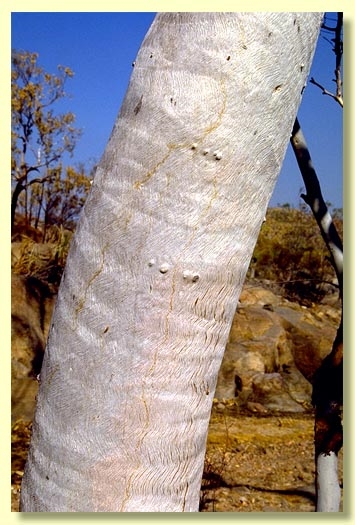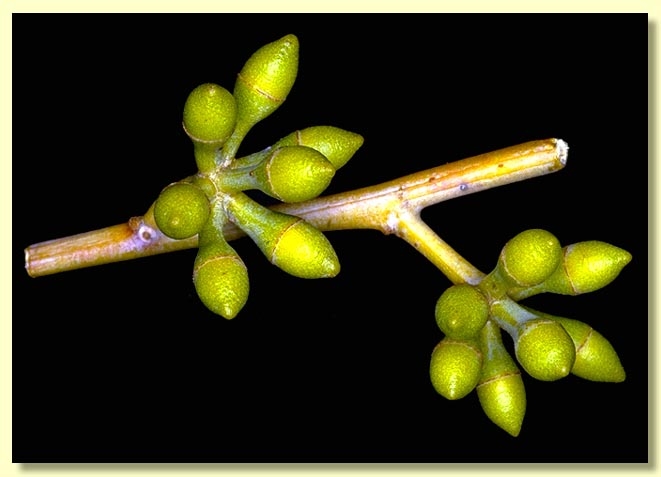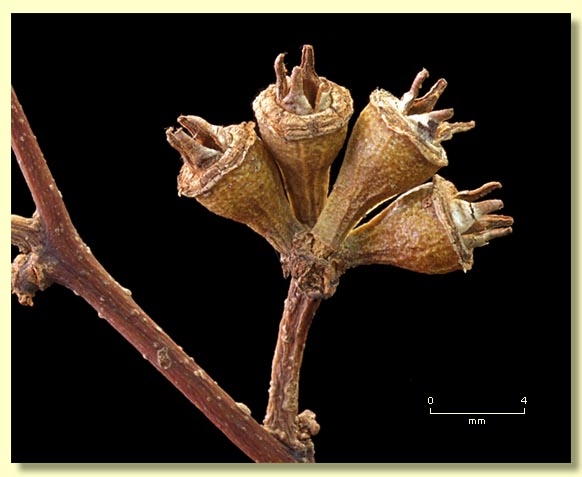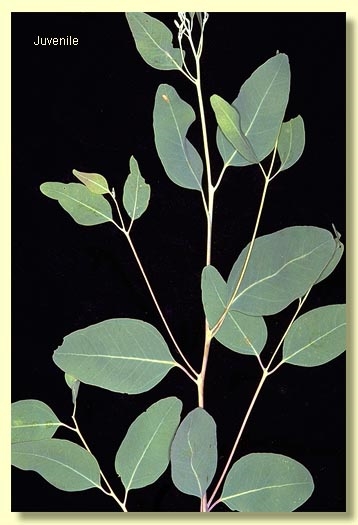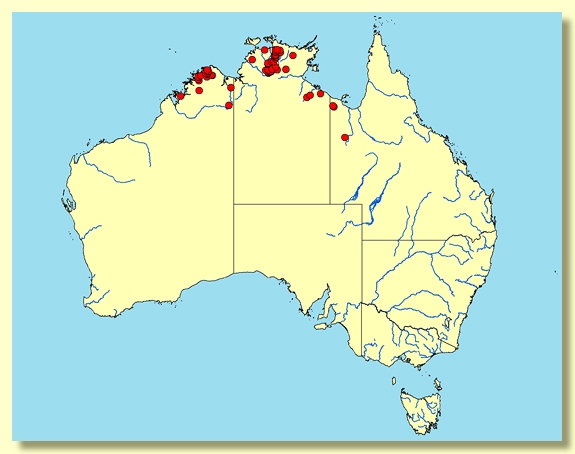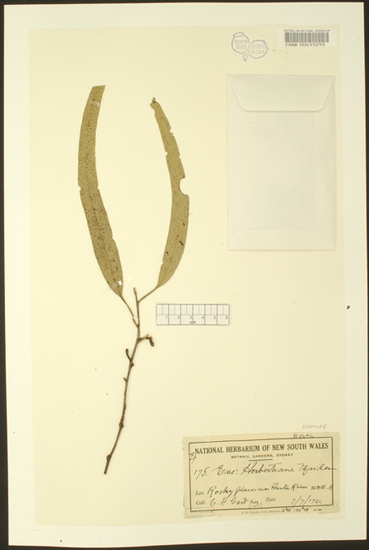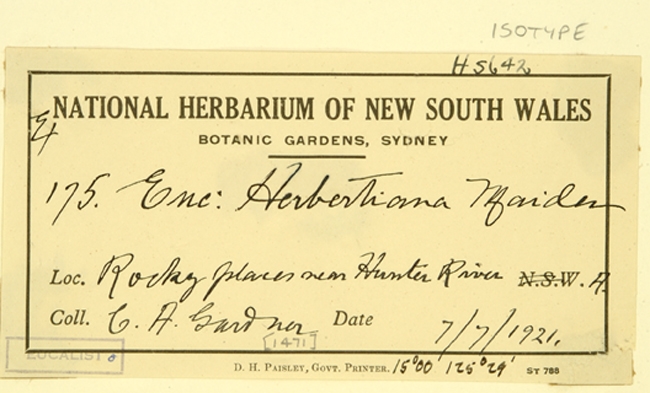Euclid - Online edition
Eucalyptus herbertiana
Eucalyptus | Symphyomyrtus | Exsertaria | Subexsertae | Pyramidales
Eucalyptus herbertiana Maiden, Crit. Revis. Eucalyptus 6: 429-30 (1923).
T: Donkins Hill near Mitchell River, Western Australia, 7 July 1921, C.A.Gardner 1471; holo: NSW; iso: CANB, PERTH.
Small tree or mallee to ca 10 m tall. Forming a lignotuber.
Bark smooth and powdery throughout, new bark creamy-yellow, maturing to white. Branchlets usually not glaucous, but occasionally slightly glaucous.
Juvenile growth (coppice or field seedlings to 50 cm): stems square to round in cross-section, glaucous; juvenile leaves petiolate, alternate, ovate, 7–10 cm long, 3.5–6.5 cm wide, base rounded to tapering, dull blue-grey to glaucous.
Adult leaves alternate, petiole 1–3 cm; blade narrowly lanceolate to lanceolate, sometimes falcate 8–22 cm long, 1–2.2(2.6) cm wide, base tapering to the petiole, margin entire, apex pointed, concolorous, dull green to grey-green, side-veins acute or at a wider angle than 45° to the midrib, reticulation dense to very dense, intramarginal vein present, oil glands small, island and intersectional.
Inflorescence axillary unbranched, peduncles 0.3–1.4 cm long, buds per umbel 7, rarely 3-budded, sessile to shortly pedicellate (pedicels 0.1–0.5 cm long). Mature buds ovoid, 0.4–0.8 cm long, 0.25–0.4 cm wide, green or rarely glaucous, scar present, operculum conical (0.2–0.4 cm long), hypanthium sometimes 2-angled, stamens irregularly flexed or with some outer stamens erect and the inner ones inflexed, anthers oblong, versatile, dorsifixed, dehiscing by longitudinal slits, style long and straight, rarely hooked beneath the operculum, stigma blunt, locules usually 4, the placentae each with 4 to 6 vertical rows of ovules. Flowers white.
Fruit sessile to shortly pedicellate (pedicels 0–0.4 cm long), cup-shaped to hemispherical to obconical, 0.25–0.5 cm long, 0.4–0.6 cm wide, usually not glaucous, disc raised, convex to annular, valves 4, strongly exserted.
Seeds dark brown, 1–1.5 mm long, ± obliquely pyramidal, dorsal surface shallowly reticulate, ventral surface ribbed, edge of seed sharply toothed, hilum terminal.
Cultivated seedlings (measured at ca node 10): cotyledons shallowly bilobed, stem square in cross-section, glaucous; leaves opposite for c. 5 to 6 nodes, then alternate, always petiolate, ovate to broadly lanceolate, 5.5–11 cm long, 2.5–5 cm wide, base rounded to tapering to the petiole, dull grey-green to slightly glaucous.
Flowering has been recorded in January, June, July, November and December.
A small tree or mallee growing on rocky slopes or sandstone escarpments from the Mitchell Plateau region of the western Kimberley, extending east through the Kulumburu – Drysdale River area to Kununurra and Bungle Bungle area, extending across the border into the Northern Territory with an isolated occurrence near the Litchfield National Park, then further east into the Kakadu and Katherine Gorge National Parks, through to the McArthur River area and just across the border into the Wollogorang–Doomadgee region of Queensland. Characterised by the smooth white powdery bark, the distinctly petiolate, concolorous, lanceolate adult leaves, the seven-budded umbels and the relatively small, sessile to shortly pedicellate buds and fruit, the fruit with a narrow disc and prominently exserted valves.
Eucalyptus herbertiana belongs to a small group of species closely related to the red gums. This group is distinguished by having smooth powdery bark, adult leaves with dense to very dense reticulation and intersectional or absent oil glands, buds with incurved or erect stamens, fruit with an annular disc and obliquely pyramidal, toothed seeds with a more or less terminal hilum. Other members of this group are E. mooreana, E. pantoleuca, E. cupularis, E. glomericassis and E. gregoriensis.
Within this group, E. herbertiana is closest to E. cupularis and E. gregoriensis. It can be distinguished from E. cupularis by the width of the fruit and thelack of white wax on the buds and fruit. In E. herbertiana the fruit is 0.6 cm or narrower and the buds and fruit normally not glaucous, while E. cupularis has larger fruit, 0.7 cm or wider and glaucous buds and fruit. It differs from E. gregoriensis by having longer umbel peduncles, usually longer than 0.5 cm, and seven-budded umbels (E. gregoriensis with umbel peduncles shorter than 0.5 cm and three-budded umbels). It is distinguished from E. glomericassis by having dull green to grey-green adult leaves and a relatively narrow disc on the fruit (E. glomericassis with glossy green adult leaves and a relatively broad disc). It is easily distinguished from the other two members of the group, i.e. E. mooreana and E. pantoleuca, by its adult leaf shape and position. E. herbertiana has petiolate, lanceolate, alternate adult leaves, while E. mooreana has sessile, opposite, elliptical to ovate adult leaves and E. pantoleuca has petiolate, more or less opposite, orbicular to deltoid adult leaves
Within its area of occurrence, E. herbertiana may be confused with other related white gums, i.e. E. alba var. australasica, E. apodophylla, E. brevifolia, E. confluens, E. houseana, E. leucophloia, E. ordiana, E. rupestris and E. umbrawarrensis.
E. alba var. australasica is distinguished by having broadly lanceolate adult leaves usually wider than 2.5 cm, while E. herbertiana has narrowly lanceolate to lanceolate adult leaves normally narrower than 2.5 cm. Likewise E. apodophylla has broadly lanceolate to elliptical to ovate adult leaves normally wider than 3 cm. It can be further distinguished by having opposite to sub-opposite, sessile to shortly petiolate adult leaves (E. herbertiana with alternate, distinctly petiolate adult leaves). E brevifolia and E. confluens both have fruit with a broad flat disc and valves that are near the rim or very slightly exserted (E. herbertiana with a narrow ascending disc and prominently exserted valves). E. confluens is distinguished further by having glossy adult leaves (always dull in E. herbertiana). E. houseana and E. leucophloia can be distinguished by the valves of the fruit which are near the rim or slightly exserted, while prominently exserted in E. herbertiana. E. ordiana is distinguished by having broad, ovate to deltoid, glaucous to blue-grey adult leaves. Conversely, E. rupestris is distinguished by having small, elliptical to ovate adult leaves and small cylindrical fruit with the valves near the rim. E. umbrawarrensis is distinguished by having glossy green adult leaves.
E. camaldulensis subsp. obtusa, another smooth-barked gum with white or grey bark and distantly related to E. herbertiana, does occur in the same area as E. herbertiana. It can be easily separated on seed colour and shape. E. camaldulensis subsp. obtusa always has yellow, smooth, cuboid seed, while the seed from E. herbertiana is normally dark brown, toothed and more or less obliquely pyramidal. If seed is not available, then the two can be separated bud shape. E. camaldulensis subsp. obtusa has ovoid distinctly pedicellate buds with a broadly conical to rounded operculum. E. herbertiana has ovoid buds with an acute operculum. Habitat is a good guide with E. camaldulensis subsp. obtusa occurring along streams and E. herbertiana occurring on rocky elevated areas.
Eucalyptus herbertiana: named in honour of Desmond Andrew Herbert (1898–1976). Desmond Herbert commenced his career in botany as a botanical assistant, Explosives Section, Mines Department of Western Australia, in 1919 and later was Economic Botanist and Plant Pathologist in the same state. Following this, he was appointed, for a short period, as Professor of Plant Physiology at the University of the Philippines before becoming a lecturer at the Botany Department, University of Queensland and then Professor of Botany (1948–65) and finally Dean of the Faculty of Science.


